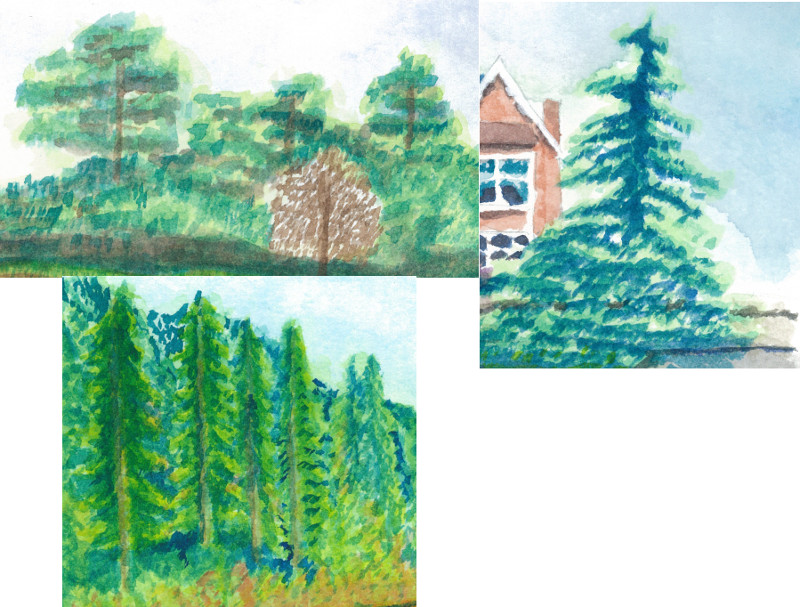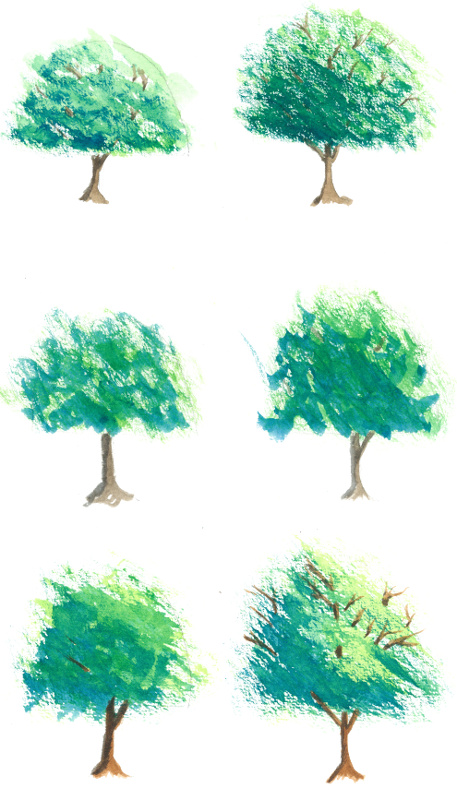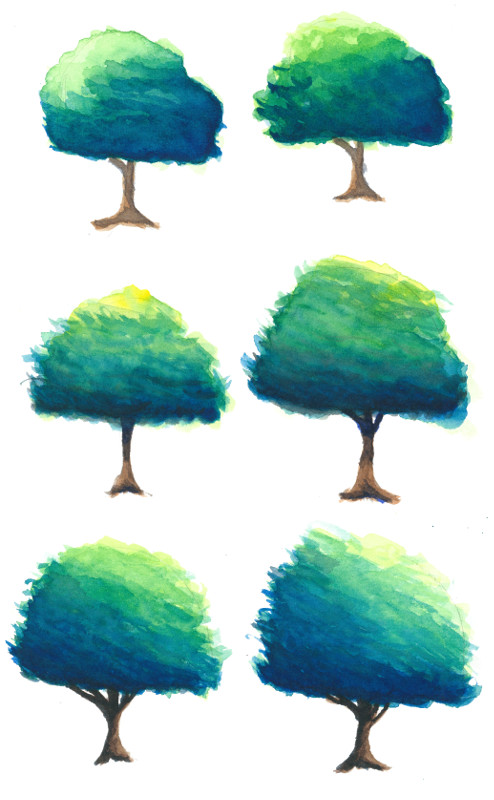Home › Forums › Explore Media › Watercolor › Watercolor Studio › I finally figure out how to paint tree.. but why it look so cartoony?
- This topic has 4 replies, 3 voices, and was last updated 5 years ago by
 snoball.
snoball.
-
AuthorPosts
-
April 1, 2019 at 2:58 am #471364
Well before we start, let’s take a look at how I used to paint tree… yeah it’s safe to said that I suck at it..

So I decide to learn all I can about painting tree… all of them seems to be using the same technique, dry brushing.. so i decide to give it a try…
Yeah, for some reason my dry brushing tree look noting like what those video showing… Not really sure what I do wrong here, probably just lack of experience…
However, one thing that I dont like is, how empty the tree looks.. so I have to fill it with branches and it just look too weird.. again probably because I just lack of experience.. but I got me thinking… What If I took what I learn but apply it to my style since dry brushing isnt working for me…

Annnnd, this is the result.. I’m very happy with it.. my tree finally look like a tree and not just bunch of green blob with squishy lines.. and the layering works pretty well.. now my tree look full and massive..
The only problem is….. It look like cartoon… Why? can someone give me some pointer? I mean I dont mind that it look like cartoon, but I want to understand it why it look the way it is..

Thanks.
April 1, 2019 at 2:22 pm #808422I think maybe a part of the problem is that it lacks shading in the right tones and areas. Also, the strokes you’re using are all going in the same direction. In the bottom image, at the bottom of it, you’ve seemed to paint slanted lines starting on the top and going to the bottom. Tree leaves and branches are more random than that in real life. And you’d see some branches peeping through here and there, but since a watercolor is painted from light to dark, you’d be painting those in after the foliage is painted.
Also, even though you’ve painted your light coming from the upper right, your shading is in layers from top to bottom. With a real tree, though, the lighting wouldn’t be that stratified. It would vary all over the tree because of the difference in length and shape of the branches.
I started with oils and in my experience, it’s much harder to paint a realistic tree with watercolors. I can see you’re making good progress, so hang in there and keep perfecting your technique. You’re on the right track.
Coming back to suggest something—maybe if you trim a brush or fan brush into a sort of jagged edge or something like that, you might be able to use a similar technique to what I’m used to doing in oils. If you just dab this uneven brush at random over the tree with your different colors, you can give the impression of a lot of leaves and the light that will occur in places where you can see the sky or the trunk where there aren’t any leaves in the way. However, though, less will be more. I tend to think, “oh this is looking cool” and then I get carried away and do much more than I should with the dabbing and leaf making. With oils, it’s easy enough to achieve the right effect with oils, but with watercolors, it’s more important to be sure that you’ve let a “dabbed” area completely dry before dabbing with another shade.
And another thing—don’t forget to touch your brush to a paper towel or rag to remove some of the paint from the brush before dabbing on your leaves. You don’t want to just end up with smeary blobs.
April 2, 2019 at 3:15 am #808424I think maybe a part of the problem is that it lacks shading in the right tones and areas. Also, the strokes you’re using are all going in the same direction. In the bottom image, at the bottom of it, you’ve seemed to paint slanted lines starting on the top and going to the bottom. Tree leaves and branches are more random than that in real life. And you’d see some branches peeping through here and there, but since a watercolor is painted from light to dark, you’d be painting those in after the foliage is painted.
Yeah, that is one thing I’m trying to work out.. being random is a lot harder than I though since when I start everything look random, but as layer build up overtime, everything just ended up going in the same direction.. so at the end I just decide to roll with it and make everything going in the same direction.. XD
Do you have any advice in being random?
Also, even though you’ve painted your light coming from the upper right, your shading is in layers from top to bottom. With a real tree, though, the lighting wouldn’t be that stratified. It would vary all over the tree because of the difference in length and shape of the branches.
I’ll keep that in mind next time.
Coming back to suggest something—maybe if you trim a brush or fan brush into a sort of jagged edge or something like that, you might be able to use a similar technique to what I’m used to doing in oils. If you just dab this uneven brush at random over the tree with your different colors, you can give the impression of a lot of leaves and the light that will occur in places where you can see the sky or the trunk where there aren’t any leaves in the way. However, though, less will be more. I tend to think, “oh this is looking cool” and then I get carried away and do much more than I should with the dabbing and leaf making. With oils, it’s easy enough to achieve the right effect with oils, but with watercolors, it’s more important to be sure that you’ve let a “dabbed” area completely dry before dabbing with another shade.
And another thing—don’t forget to touch your brush to a paper towel or rag to remove some of the paint from the brush before dabbing on your leaves. You don’t want to just end up with smeary blobs.
I did have a little experience with that since i remember doing something similar with acrylic during highschool years ago (my only time using acrylic paint for paint other than plastic model).. I remember using a pretty hard brush and having both light green and dark green on the brush and then we just dab it randomly and lightly on the paper…
but for now, I want to avoid using any specialty brush since I want to keep the number of brushes low..
April 2, 2019 at 5:01 pm #808421It looks like you may have been watching Geoff Kersey’s video on painting trees.
http://www.youtube.com/watch?v=CnH1yxXsJB8
It’s a very good instructional video. The key to this method is to use rough textured paper and a dry, scumbeling touch with your brush, laying it almost flat with the paper. Mix your greens as he shows, don’t use green colors right out of the tube. It will take a little practice, but that’s the only way to learn with watercolor.

Rich
April 2, 2019 at 6:36 pm #808423In addition to what Rich says, I also suggest that you remember the old American saying “less is more”. One of the problems I’ve had, even in the past when learning to use oils, was that I’d do a certain method and it would look so good that I’d keep on adding more of it but then I’d mess the whole thing up. That was really the wrong move. And I still sometimes have done it with watercolor.
I’m still learning. I started with watercolors about 18 months ago maybe, so I still don’t have a bunch of answers. What I’ve chosen to do, though, is to just go gradually and slowly. I mix pale washes, make sure to let layers completely bone dry, and build up the color very gradually and then as I layer, to make sure that the strongest colors aren’t put on too soon and in the wrong places. Better to err on the side of caution.
It sounds stupid, but whenever I create art or do any other kind of art endeavor, I get so in a hurry to see what the finished item will look like that I just rush too much. I always painted wet in wet with oils because I didn’t have the patience to wait for layers and areas to dry. Then I learned to thin my paint with a mixture of oil, turpentine, and varnish to thin the paint down with so that by the next day, it would be tacky enough to proceed.
With watercolor, I have a similar problem. I don’t like to wait for drying so I just dry brush a lot (with paint on the brush, of course) rather than taking the time to do washes and let them dry or use a blow dryer on the work. I’m still working on patience and better techniques, though.
I’m sure you’ll do really well once you just keep practicing. It seems as though for every blooper I do, my experience and learning really bounds ahead a little bit, so it’s all worthwhile. I saw one of the members on here say that he prefers to think of it that he either succeeds or he learns something. He doesn’t choose to see anything as a failure. I like that, so I’m trying to see my own work like that, too.
-
AuthorPosts
- You must be logged in to reply to this topic.
Register For This Site
A password will be e-mailed to you.
Search